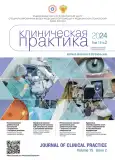Clinical examples of correct orientation of a toric intraocular lens in patients with postkeratotomic corneal ectasia
- Authors: Kuznetsov I.V.1, Pasikova N.V.1
-
Affiliations:
- The S. Fyodorov Eye Microsurgery Federal State Institution
- Issue: Vol 15, No 2 (2024)
- Pages: 65-72
- Section: Case reports
- URL: https://journals.rcsi.science/clinpractice/article/view/262731
- DOI: https://doi.org/10.17816/clinpract624472
- ID: 262731
Cite item
Full Text
Abstract
BACKGROUND: Surgical treatment of cataract in patients with postkeratotomic corneal ectasia has various features. First, difficulties arise when calculating the optical strength of an intraocular lens and its cylindrical component and determining the location of the main axes of astigmatism for toric intraocular lens implantation. Additionally, not all modern keratotopography installations are able to accurately determine the refractive power of the cornea in such patients owing to pronounced irregular astigmatism and a large difference in keratometric parameters in the main meridians.
CLINICAL CASES DESCRIPTION: Two clinical cases of surgical treatment of cataract in combination with postkeratotomic keratectasia are presented. Patients underwent a standard preoperative ophthalmological examination. TMS-4 Tomey keratotopograph was used to accurately determine the refractive power of the cornea. The optical power of toric intraocular lens were calculated using the Holladay 2 formula with amendments for radial keratotomy and the Johnson & Johnson VISIC online calculator. SN6AT9 intraocular lens (Alcon) and a Tecnis ZCT800 toric intraocular lens (Johnson & Johnson) were implanted in patients. The orientation of the position of the cylinder axis of toric intraocular lens was performed perpendicular to the most flattened meridian, corresponding to the position of the keratectasia zone, determined by the most expanded keratotomy scar. Before surgery, the best corrected visual acuity of patient M was OD=0.2, OS=0.4 and that of patient K was OD=0.4, OS=0.2. After surgery, the best corrected visual acuity of patient M was OD=0.8, OS=0.8 and that of patient K was OD=0.8, OS=0.7.
CONCLUSION: This study aimed to familiarize practicing ophthalmologists, clinical residents, and postgraduates with a possible treatment option for cataracts by phacoemulsification with implantation of a toric intraocular lens in patients with postkeratotomic keratectasia. The resulting high visual acuity and subjective satisfaction of patients indicate the accuracy of chosen treatment tactics. A reliable visual guide for choosing the cylinder axis is the meridian of the greatest degree of keratectasia (cornea flattening), which is determined by the maximally expanded keratotomy scar position. The intraocular lens cylinder axis is oriented perpendicular to the keratectasia meridian. Ultrasound phacoemulsification of cataract with implantation of a toric intraocular lens is an effective method for correcting induced ametropia after radial keratotomy against the background of postkeratotomy keratectasia with high astigmatism.
Full Text
##article.viewOnOriginalSite##About the authors
Igor V. Kuznetsov
The S. Fyodorov Eye Microsurgery Federal State Institution
Author for correspondence.
Email: shtirlic-ku@mail.ru
ORCID iD: 0000-0003-4525-1797
SPIN-code: 7880-0578
Russian Federation, Orenburg
Natalia V. Pasikova
The S. Fyodorov Eye Microsurgery Federal State Institution
Email: natiracool@mail.ru
ORCID iD: 0000-0002-5693-6209
SPIN-code: 6503-1027
MD, PhD
Russian Federation, OrenburgReferences
- Wellish KL, Glasgow BJ, Beltran F, Maloney RK. Corneal ectasia as a complication of repeated keratotomy surgery. J Refract Corneal Surg. 1994;10(3):360–364.
- Nagpal R, Sharma N, Bafna RK, et al. Tuck-in deep anterior lamellar keratoplasty for the management of post-radial keratotomy keratectasia. J Cataract Refract Surg. 2022;48(8):937–941. EDN: IGHVVS doi: 10.1097/j.jcrs.0000000000000900
- Pellegrini M, Yu AC, Busin M. Large-diameter modified big-bubble deep anterior lamellar keratoplasty in post-radial keratotomy eyes. Am J Ophthalmol. 2023;(251):1–4. EDN: LTYPCZ doi: 10.1016/j.ajo.2022.12.012
- Motwani M. Treatment of corneal irregularity in radial/astigmatic keratotomy patients utilizing WaveLight Contoura. Clin Ophthalmol. 2022;11(16)111–126. EDN: VUYAPQ doi: 10.2147/OPTH.S328050
- Meduri A, Oliverio G, Severo AA, et al. Double safe suture during cataract surgery on post radial keratotomy patients using clear corneal incisions. Eur J Ophthalmol. 2022;32(3):1828–1832. EDN: JFUHQM doi: 10.1177/11206721221083799
- Canedo AL, Wang L, Koch DD, Al-Mohtaseb Z. Accuracy of astigmatism correction with toric intraocular lens implantation in eyes with previous radial keratotomy. J Cataract Refract Surg. 2022;48(4):417–420. EDN: MXVTBK doi: 10.1097/j.jcrs.0000000000000779
- Cubuk MO, Bilgihan K. Performing corneal collagen cross-linking after radial keratotomy in a patient with keratoconus: case report. Beyoglu Eye J. 2019;4(3):206–209. doi: 10.14744/bej.2019.79653
- Ferreira TB, Marques EF, Filipe HP. Combined corneal collagen crosslinking and secondary intraocular lens implantation for keratectasia after radial keratotomy. J Cataract Refract Surg. 2014;40(1):143–147. doi: 10.1016/j.jcrs.2013.10.026
Supplementary files












